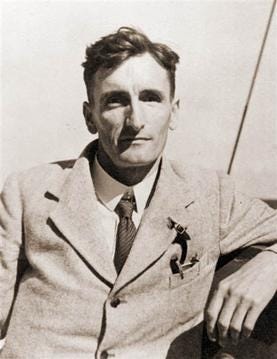In April 1938, in the shadow of World War II, an English engineer and amateur meteorologist named Guy Stewart Callendar published a paper that would, in time, become one of the most influential papers on climate change science. It appeared in the Quarterly Journal of the Royal Meteorological Society—and introduced what we now call the Callendar Effect.
In this paper, titled, “The artificial Production of Carbon Dioxide and its Influence on Temperature,” Callendar made a daring assertion: burning fossil fuels was adding carbon dioxide to the atmosphere, and this was warming the Earth.
Callendar came from a lineage of science and engineer. His father, physicist Hugh Callendar, nurtured a household of scientific inquiry and mechanical enthusiasm. A childhood accident left Guy blind from his left eye, barring him from military service in the First World War. Instead, he contributed to the Air Ministry’s X-ray Committee, working in his father’s laboratory at Imperial College, where he helped test aircraft engines and pioneering submarine detection technologies based on low-frequency sound. In 1926, he co-authored his first scientific paper—on the total heat of steam—with his father.
The Callendar Effect

But Callendar’s true passion lay beyond engines and laboratories: it was the weather. In his spare time, he was gathering temperature data and weather data from around the world, which he recorded in his daily weather diary. Long before computers, he hand-calculated temperature trends using data from 147 weather stations around the world. His measurements were so accurate that “they were used to correct the official temperature records of central England”.
His conclusion was remarkable: from 1880 to the early 1930s, humans had emitted an estimated 150 billion tonnes of CO₂, contributing to a slow but steady global warming—approximately 0.003°C per year.
“…. the greater part of the warmth of recent years,” he noted, “has occurred in the northern regions … all show a decided rising tendency since about 1920.”
Callendar also examined how oceans absorb carbon dioxide, describing them as vast regulators. He observed that the sea “holds some sixty times as much [CO₂] as the atmosphere.”
Current estimates suggest that around 25% of all human CO₂ emissions have been taken up by the oceans. This long-term uptake of carbon into the ocean comes with a cost. It’s slowly causing the acidification of the oceans—as sea water takes up more CO₂ it is altering the ocean chemistry and lowering its pH, and this cannot easily be reversed.
Despite arguing that “… Few of those familiar with the natural heat exchanges of the atmosphere which go into the making of our climates and weather would be prepared to admit that the activities of man could have any influence upon phenomena of so vast a scale,” Callendar remained optimistic. Like Svante Arrhenius before him, he speculated that rising CO₂ might “prove beneficial to mankind in several ways,” like in agriculture, especially in colder climates. Perhaps, he thought, fossil fuel emissions might delay indefinitely a future ice age.
At the time, the scientific community paid little attention to Callendar’s insights. It wasn’t until 1957, on the eve of the International Geophysical Year, that Roger Revelle and Hans Suess rediscovered his work, and coined the term “Callendar Effect” to describe the “climatic change brought about by anthropogenic increases in the concentration of atmospheric carbon dioxide, primarily through the processes of combustion.”
Callendar continued his research through the 1940s and in 1949 published a popular article, titled Can Carbon Dioxide Influence Climate? warning that CO₂ was rising even faster than fuel use alone could explain. He cited deforestation and land-use change as additional drivers—decades before these concerns entered the global conversation.
That was 87 years ago.
Sources:
Callendar, G. (1938). The artificial production of carbon dioxide and its influence on temperature, Quartely Journal of Royal Meteorological Society. doi:https://doi.org/10.1002/qj.49706427503
Nicolas Gruber, e. al. (2019). The oceanic sink for anthropogenic CO2 from 1994 to 2007 (Vols. Vol 363, Issue 6432). Science. doi:https://www.science.org/doi/10.1126/science.aau5153
Callendar, G. (1949, October). Can Carbon Dioxide Influence Climate? Weather, 4(10), 310-314. doi:https://doi.org/10.1002/j.1477-8696.1949.tb00952.x
Fleming, J. R. (2003). What Role Did G.S. Callendar Play in Reviving the CO2 Theory of Global Climate Change? Presidential Symposium on History of Meteorology, American Meteorological Society. Long Beach.
Fleming, J. R. (2007). The Callendar Effect: The Life and Work of Guy Stewart Callendar (1898-1964). American Meteorological Society.


